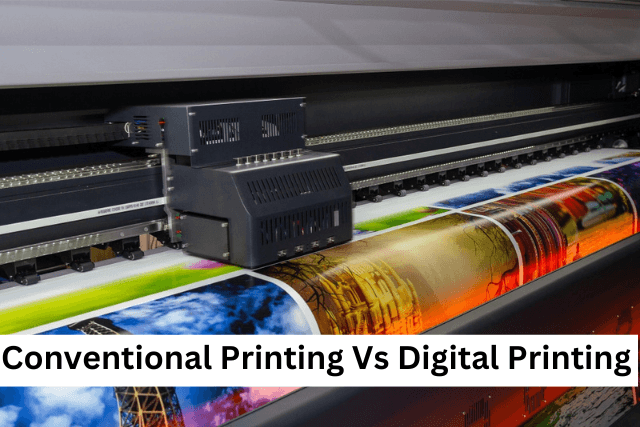Printing has evolved significantly, transitioning from traditional methods to modern technologies that have revolutionized the industry. Conventional printing and digital printing are two prominent approaches that serve various purposes, each with its own set of advantages and limitations. In this article, we delve into the world of printing technologies, exploring the nuances, benefits, and considerations of conventional printing and digital printing.
Conventional Printing: The Traditional Art
Conventional printing, also known as offset printing, has been the cornerstone of the printing industry for centuries. It involves transferring ink from a plate to a rubber blanket and then onto the printing surface. This process allows for high-quality, consistent results and is often used for large-volume printing projects such as newspapers, magazines, and brochures.
Advantages of Conventional Printing
Cost-Effective for Large Volumes: Conventional printing becomes cost-effective when producing large quantities of printed materials. As the volume increases, the cost per unit decreases, making it a preferred choice for mass production.
High-Quality Output: The offset printing process delivers sharp and consistent results, with precise color matching and excellent image reproduction. This is especially crucial for materials that demand superior image quality.
Versatility in Substrates: Conventional printing can be performed on a wide range of substrates, including various paper types, cardstocks, and even non-paper materials like plastics and metals.
Pantone Color Matching: For projects that require specific color accuracy, such as branding materials, Pantone color matching is achievable with conventional printing, ensuring consistent brand representation.
Limitations of Conventional Printing
Setup Time and Costs: The setup process for conventional printing involves creating printing plates, which can be time-consuming and costly. This makes it less practical for small print runs.
Waste Generation: The setup process and initial prints may generate waste as colors are adjusted and calibrated. This is a concern, especially in today’s eco-conscious environment.
Longer Turnaround Times: Due to the setup involved, conventional printing often has longer turnaround times compared to digital printing, which can affect projects with tight deadlines.
Digital Printing: The Technological Leap
Digital printing, a more recent addition to the printing landscape, involves transferring digital images directly onto the printing substrate. It eliminates the need for plates and offers greater flexibility for on-demand printing and customization.
Advantages of Digital Printing
Short Run Printing: Digital printing shines when it comes to short print runs. It eliminates the need for setup time and plates, making it cost-effective and efficient for producing smaller quantities.
Quick Turnaround Times: The absence of setup processes and plates results in quicker turnaround times, which is particularly advantageous for projects with tight deadlines.
Variable Data Printing: Digital printing allows for personalized content, enabling each printed piece to include unique text, images, or other elements. This is highly useful for direct marketing and personalized communications.
Reduced Waste: With minimal setup, digital printing generates less waste during the initial stages of a print job, aligning well with sustainability goals.
Limitations of Digital Printing
Color Consistency: While digital printing technology has improved significantly, achieving consistent color matching, especially Pantone colors, can be more challenging compared to conventional printing.
Print Quality at Scale: Digital printing may exhibit some limitations in print quality when producing large quantities. Fine details and gradients might not reproduce as well as in offset printing.
Substrate Constraints: While digital printing can handle various substrates, certain specialty papers or materials may not be compatible with digital presses.
Choosing the Right Printing Method: Considerations
Selecting the appropriate printing method depends on various factors, including the project requirements, budget, timeline, and desired print quality.
Volume: For large print runs, conventional printing offers cost-effective solutions due to its economies of scale. Digital printing is more suitable for short print runs and customized materials.
Print Quality: When uncompromised print quality and color accuracy are vital, conventional printing is the preferred choice. However, digital printing has made significant strides in improving print quality and is suitable for most applications.
Customization: If personalization or variable data printing is essential, digital printing provides seamless integration of individualized content.
Turnaround Time: When time is of the essence, digital printing’s quick setup and production make it an ideal solution.
Budget: While conventional printing becomes cost-effective for large volumes, digital printing’s short setup time and suitability for short runs might be more budget-friendly for certain projects.
Conclusion
Conventional and digital printing are two distinct yet complementary technologies catering to a wide range of printing needs. Conventional printing’s historical significance, exceptional print quality, and cost-effectiveness for large volumes make it a steadfast choice for many projects. On the other hand, digital printing’s flexibility, quick turnaround times, and suitability for short runs and personalization make it a game-changer in today’s dynamic printing landscape. By understanding the strengths and limitations of each method, businesses and individuals can make informed decisions to meet their specific printing requirements while harnessing the benefits of both traditional craftsmanship and modern technological advancements.










